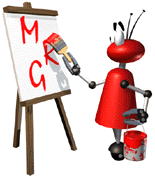
Chris Adams
MOBILE ROBOTICS RESEARCH GROUP
navigation
Contact: John Hallam
Last updated: Fri Dec 1 22:15:23 2000

Chris Adams MOBILE ROBOTICS RESEARCH GROUP navigation
Contact: John Hallam
|
The Really Useful Robot (RUR) project produced some early examples of qualitative, sensori-motor map learning in behaviour based robotics. The RUR mobile robots were constructed out of Fisher-Technic and used only simple sensors (e.g., whiskers and crude odometry). These robots lived in large maze-world enclosures and, whilst exploring their environment, they learned a self-organizing feature map (SOFM) containing representations of important landmarks. Unlike most maps around at the time, these SOFMs did not use geometric primitives to encode physical space, but rather, landmarks were remembered by the patterns of sensori stimuli and/or motor actions which the robot experienced in the presence of that landmark. |